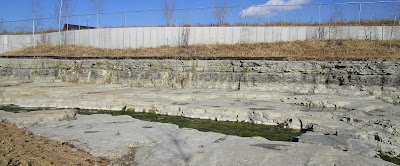Every year a handful of new croc taxa are described. If you're strictly in this business for the dinosaurs, you ought to see what the croc side of Archosauria has been up to from time to time; they were quite versatile in palmier days. Even though they aren't quite as diversified as they used to be, it turns out they had hitherto-unsuspected tricks up their sleeves even as recently as a few hundred years ago. This spring a new genus and species of gavialid was described from the Holocene of south China: Hanyusuchus sinensis. This is fascinating, for many reasons. The obvious is that here we have a species of [insert expletive of choice] 20-foot-long gavial that existed up to perhaps a few hundred years ago in full contact with one of the most thoroughly documented civilizations in history, and it was completely overlooked. It may not have gone extinct until the time of the Ming dynasty. This is something like discovering that bears in Greek and Roman mythology were actually Arctodus, only if Arctodus was the size of a pickup truck. China, of course, is noted for the extant Alligator sinensis, but although the Chinese alligator is many things, not even on its best days has it been a 20-foot-long gavial.
 |
| Figure 2(s) from Iijima et al. (2022). Depicted: Hanyusuchus sinensis (composite, scaled to holotype) and 1.8 m (5.9 ft) tall human. Not pictured: Alligator sinensis (to imagine, mentally scale the Hanyusuchus to be about the same size as the human). CC BY 4.0. |
Another fascinating aspect is the namesake. Han Yu was a significant writer, philosopher, and politician of the Tang dynasty. At one point in his life, he got in trouble at court and was packed off to Chaozhou in Guangdong, southeastern China to serve as prefect. In this capacity, he issued a proclamation in 819 concerning the crocodilian population. This in itself is not remarkable, except for the audience: he issued it to the crocodiles themselves. A translation of the statement can be found here (well worth a read). The icing on the cake is that the crocodiles reportedly did as instructed and departed, although we can presume that if they *did* indeed vanish from the area, strong hands wielding metal implements (like the Bronze Age weapons that left marks on some specimens) were more important in enforcing the departure. The reader may suppose that Han Yu's action was just a quaint old-time delusion; after all, there is a long history of animals being prosecuted for crimes. However, as the author of the translation notes drily, "Tang prefects did not habitually make formal verbal addresses to the local fauna" (footnote 7, p. 60). One wonders if perhaps Han Yu, who was noted for a sense of humor, had his tongue firmly in cheek.
There's also a melancholic existential aspect to the discussion. H. sinensis was part of the fabric of life in southern China for thousands of years. Descriptions of the species can be identified in historical sources, now that we know what to look for. Dynasties, cultural flowerings and renaissances, wars, conquerors, travelers like Marco Polo and Ibn Battuta, all came and went while 6-m gavials patrolled the southern rivers. They took livestock and killed people. They were apparently very noisy, probably the source of reportedly "thunder-like sounds in the night". Then they were driven into extinction and basically forgotten for hundreds of years.
References
Iijima M, Qiao Y, Lin W, Peng Y, Yoneda M, and Liu J. 2022. An intermediate crocodylian linking two extant gharials from the Bronze Age of China and its human-induced extinction. Proceedings of the Royal Society B: Biological Sciences 289:20220085. doi:10.1098/rspb.2022.0085.

